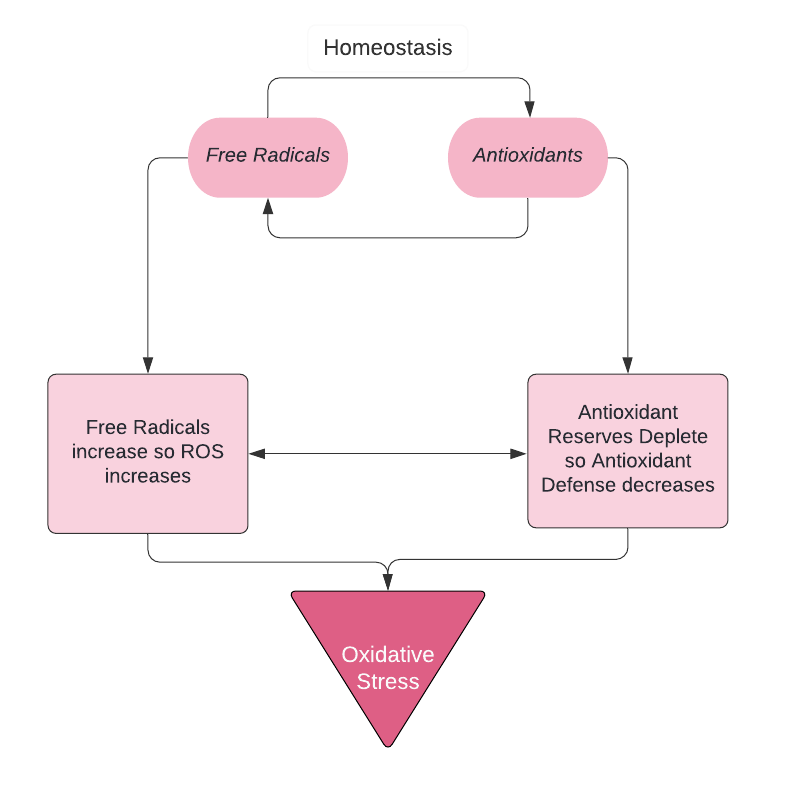Free Radicals and Oxidative Stress
Free Radicals and Reactive Oxygen Species
Free radicals are species that have one or more unpaired electrons.15 They are formed in one of two ways. From their original (non-radical) state, the species either loses or gains a single electron to become a free radical. Free radicals are highly reactive with each other or other molecules. The term reactive oxygen species (ROS) is also used because some reactive oxygen molecules are not free radicals, but have similar characteristics.15 ROS and free radicals cause oxidative stress. Lead is known to generate free radicals and ROS,16 which is a major reason for its toxicity.
Impact of Free Radicals and ROS on Nervous System
Free radicals and ROS impact the nervous system in several ways. Some consequences include genotoxicity, overwhelming and depleting the antioxidant reserves, and lipid peroxidation. Normally, there is a homeostatic balance between antioxidant defenses and production of free radicals.15 When this balance is disrupted due to the increase in lead levels, oxidative stress occurs, as depicted in Figure 1.

Adapted from Ref. 17.
Under lead exposure, the antioxidants are overwhelmed and cannot neutralize all of the present free radicals. The cells begin to undergo oxidative stress and may eventually die. Some targets of this oxidative stress are depicted in Figure 2. As seen, one consequence is the breakdown of the lipids in cellular membranes. The process is called lipid peroxidation. It is self propagating and highly destructive, since it could lead to all the lipids in the cell to be oxidized.15 This process has toxic byproducts, such as peroxyl radicals, making it even more detrimental.15 This is especially dangerous in the brain due to the its lipid-rich content.18 Lipid peroxidation in the brain cells causes the membranes of the cells to become damaged and ultimately die. Lead accumulation is also related to genotoxicity, as DNA experiences oxidative damage.19 This decreases cell proliferation and cell viability.19 The antioxidants glutathione (GSH) and superoxide dismutase (SOD) become depleted.19 The oxidative stress from lead exposure cause genotoxicity and prevents function of the DNA repair genes XRCC1, hOGG-1, BRCA1, and XPD.20 Cell death in the brain can cause further issues like cognitive and behavioral deficits.19 Some of these include anxiety, depression and memory loss .19,21

Adapted from Ref. 16.
The relationship between lead and oxidative stress will be discussed in terms of lipid peroxidation and ROS generation via ALAD inhibition.
December 6, 2021 at 5:32 pm
This is a very informative page and the flowcharts/visuals are very helpful. However, it may be beneficial to split this into multiple pages (or disseminate some info into other preexisting pages), as it contains a lot of information/diagrams, and much of it seems to overlap with the ALAD inhibition section.
December 6, 2021 at 10:22 pm
I agree with Daniel’s comments. Is there any way to break up this page into subpages? Maybe consider putting the section of ALAD inhibition and ROS generation on a subpage attached to the ALAD inhibition page. I understand that the section was on this page because it discusses ROS generation. However, I’d like to get a better idea of what ALAD is before talking about ROS generation from the ALA. This could shorten the page, and make it less daunting for the reader. Other than that, I felt that the page was well written and the flow charts really helped convey what you were writing in a very visual way.
December 6, 2021 at 10:32 pm
I agree with the other comments about the overlap between the info about ALA here and the ALAD inhibition page; may be better to just briefly mention it here and say the other page goes more in-depth. I’m also curious about what spin-trapping is and how lipid peroxidation works on a chemical level, but this page already has a lot of information and these things would probably take away from the main idea, so they can probably just be left out. I was also curious whether lead poisoning often causes seizures; it’s mentioned at the end that interference with GABA receptors from ROS can cause them, but the wording seemed unsure. Overall though, the figures are extremely clear and make the high volume of info on this page very digestible, and the main idea comes across extremely well.
March 27, 2025 at 8:31 pm
Thank You for this – I am a 77y/o female who has had Blood Lead levels ranging 40-60 ug/dl since 1969 – My Doctor at the VA told Me that Lead(Pb) was inert and wouldn’t hurt Me –
I got busy raising two children, etc, dealing with continuing medical issues – I have recently been studying about Oxidative Stress and now understand why my Electrolytes stay so very low – hopefully My current Doc will look into it.
BTW, I have embedded shotgun pellets in My Left chest and Shoulder –